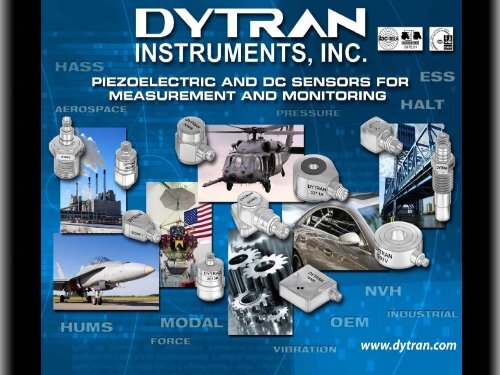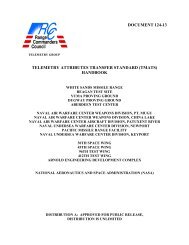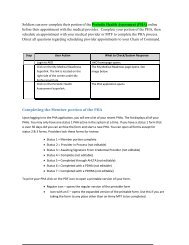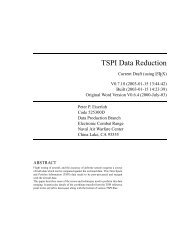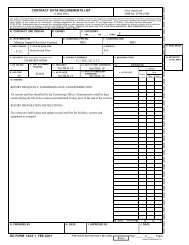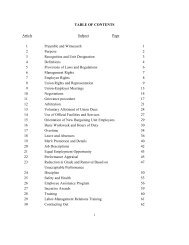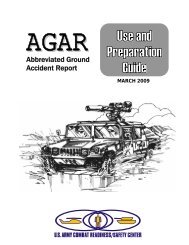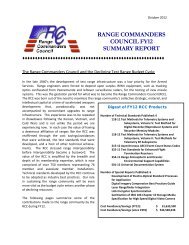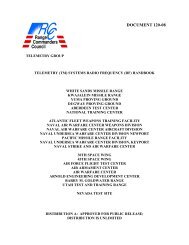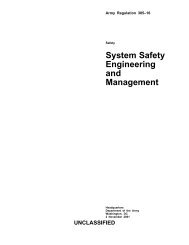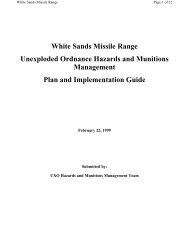TUTORIAL Introduction to Piezoelectric Sensors
TUTORIAL Introduction to Piezoelectric Sensors
TUTORIAL Introduction to Piezoelectric Sensors
- No tags were found...
You also want an ePaper? Increase the reach of your titles
YUMPU automatically turns print PDFs into web optimized ePapers that Google loves.
Dytran Instruments, Inc. 1
Installed HUMS BaseDytran sensors are installed on the following airframesfor HUMS applicationsDytran Instruments, Inc. 2
MH60 Blackhawk
A119
AS350
Bell 412
AH-64
MH47
<strong>Introduction</strong> <strong>to</strong> <strong>Piezoelectric</strong><strong>Sensors</strong>Dave Change
General Topics• Why do we use piezoelectric sensors?• Some common uses for piezo sensors• Dynamic measurement vs. static measurement• <strong>Piezoelectric</strong> transducer‒ Principle of operation‒ Information provided by the transducer• Charge mode and voltage mode (IEPE)• Transducer selection criteria• Mounting considerations• General handlingDytran Instruments, Inc.10
S<strong>to</strong>chastic Perturbation TheorySince the solution of Langevin equation will depend on the coupling constant of thetheory, look for the solution as a power expansionIf you insert the previous expansion in the Langevin equation, the tlatter gets translated in<strong>to</strong> ahierarchy of equations, , each for each order, each dependent on lower orders.We already know the solutions for φ 4 theory: Diagrammatically ...+ λ + λ 2 ( + ... ) + O(λ 3 )Now, also observables are expanded... and this is a propaga<strong>to</strong>r ...+ 3 λ ( + ) + O(λ 2 )Observation: we can get power expansions from S<strong>to</strong>chastic Quantizationation’s s main assertion, e.g.
Why do we use piezo sensors?• Small size• Light weight• 2-wire operation(IEPE)• Wide dynamic range• Wide temperaturerange• Broad frequencyrange• Ultra low noise• Simple signalconditioning• Cost effective testimplementationDytran Instruments, Inc. 12
Common Uses for <strong>Piezoelectric</strong><strong>Sensors</strong>• Modal Analysis• Environmental StressScreening (ESS)• Health and UsageMoni<strong>to</strong>ring Systems(HUMS)• Predictive /preventativemaintenance• Pyrotechnic events• Aircraft groundvibration test• Aircraft flight testDytran Instruments, Inc. 13
What fac<strong>to</strong>ry supplied documentationcomes with your accelerometer?• Operating guide• Outline installation drawing• Specification sheet• Calibration certificateDytran Instruments, Inc. 14
Outline installation drawingDytran Instruments, Inc. 15
Dytran Instruments, Inc. 16
Dytran Instruments, Inc. 17
Other <strong>Piezoelectric</strong> Devices• Today’s discussion will focus primarily onpiezoelectric type accelerometers but we use thesame principles <strong>to</strong> measure dynamic force andpressureDytran Instruments, Inc. 18
Dynamic vs. Static MeasurementDynamic Measurement• The physical quantity (i.e.acceleration, force,pressure) is rapidlychanging over time• Examples of dynamic events‒ Vibration of rotating machinery‒ Pressure in a reciprocatingengine‒ Force input <strong>to</strong> a structure via ashake tableStatic Measurement• The physical quantity beingmeasured does not changeas a function of time (orchanges very slowly)• Examples of staticmeasurements‒ Force measurement in abathroom scale‒ Constant acceleration due <strong>to</strong>gravityDytran Instruments, Inc. 19
Definition of <strong>Piezoelectric</strong>ity<strong>Piezoelectric</strong>ity is the ability of some materials (notablycrystals and certain ceramics) <strong>to</strong> generated an electricalpotential in response <strong>to</strong> applied mechanical stress. Thismay take the form of a separation of electric chargeacross the crystal lattice. If the material is not shortcircuited,the applied charge induces a voltage across thematerial. The word is derive from the Greek wordpiezien, which means <strong>to</strong> squeeze or press.Dytran Instruments, Inc. 20
What is a <strong>Piezoelectric</strong> Transducer?• A transducer converts one form of energy in<strong>to</strong> another‒ In the case of piezoelectric transducer the transduction is frommechanical energy <strong>to</strong> electrical energy• The prefix “piezo” is a Greek word meaning “<strong>to</strong> squeeze”• Materials that produce an electric charge when a force isapplied <strong>to</strong> them exhibit what is known as thepiezoelectric effect• Many piezoelectric materials are known <strong>to</strong>exist‒ Quartz, <strong>to</strong>urmaline, ceramic (PZT), GAPO4 andmany othersDytran Instruments, Inc.21
Typical IEPE Design• 3211 link <strong>to</strong>•1060 series link <strong>to</strong>•2005V seires link <strong>to</strong>
<strong>Piezoelectric</strong> Transducer• The active element in all piezoelectric devices is apiece of piezoelectric material. There are manydifferent sensor designs based on various crystalcuts and materials.• The common types (modes) of piezoelectric sensorsin use <strong>to</strong>day are:‒ Voltage mode (IEPE, LIVM, ICP, Piezotron, Isotron)‒ Charge mode‒ Each of these designs have their advantages anddisadvantagesDytran Instruments, Inc.23
<strong>Piezoelectric</strong> Sensing Element DesignsCompressionShearDytran Instruments, Inc.24
Voltage Mode Transducer• Can utilize either quartz or ceramic• Have built in or integral electronics• Low cost signal conditioning• Stable over broad temperature range• Limited upper temperature range due <strong>to</strong> built inelectronics• Many modern analyzers and data acquisitionsystems have IEPE power built in• Most voltage mode (IEPE) sensors available with TEDSoption• Ease of useDytran Instruments, Inc.25
Input / Output Characteristics ofVoltage Mode (IEPE) Sensor• Input : 18 – 24 Volts DC, 2-20mA constant current‒ Inputs other than the specified value can be harmful <strong>to</strong> thesensor• Output : voltage proportional <strong>to</strong> acceleration orvibrationNote: The IEPE or voltage mode sensor is strictly a two wiredevice (sig / power and ground)Dytran Instruments, Inc.26
Voltage Mode SetupDytran Instruments, Inc.27
Alternate Voltage Mode SetupDytran Instruments, Inc.28
Typical IEPE System DesignDytran Instruments, Inc.29
Bias Voltage Levels in Typical IEPESystemsDytran Instruments, Inc.30
IEPE Sensor Frequency Response• Low frequency response is controlled by the sensorDischarge Time Constant (DTC)‒ Fac<strong>to</strong>ry set and cannot be changed‒ Can be changed at time of manufacture• High frequency response is generally a function ofsensor resonance (natural) frequency• Filtering in the sensor or signal conditioning can alsoeffect the sensor frequency response• High sensitivity sensors generally have lowresonance frequency• Low sensitivity sensors generally have highresonance frequencyDytran Instruments, Inc.31
Frequency Response of <strong>Piezoelectric</strong>AccelerometersDytran Instruments, Inc.32
Panel Meter ExamplesTrouble Shooting Aide010BATT.O.K.2010BATT.O.K.0 20010BATT.O.K.20NORMALNORMALNORMALSHORTOPENSENSOR BIASDC VOLTSSHORTOPENSENSOR BIASDC VOLTSSHORTOPENSENSOR BIASDC VOLTSShortedNormalOpenDytran Instruments, Inc.33
Discharge Time Constant (DTC)• Discharge Time Constant – the time required for theoutput voltage from a sensor <strong>to</strong> discharge <strong>to</strong> 37% ofits original value in response <strong>to</strong> a zero rise time stepfunction input‒ Determines sensor low frequency response• Low frequency response is approximately equal <strong>to</strong>:-3dB Point = .16/DTC-5% = -3dB Point x 3Dytran Instruments, Inc.34
Charge Mode Transducers• Usually ceramic based• No built-in electronics• Good for high temperature (+500°F)• Expensive signal conditioning• Low noise cable required for most applications• Charge amps are generally more difficult <strong>to</strong> use (i.e.setting scale fac<strong>to</strong>rs, etc.)Dytran Instruments, Inc.35
Mounting Options• Stud mounting‒ Optimum frequency response• Epoxy adapter, stud mount sensor‒ Good frequency response• Magnetic mount‒ Convenient, limited frequency response• Magnetic mount <strong>to</strong> epoxied target‒ Preferable method for magnetic mountingDytran Instruments, Inc.36
Frequency Response EffectsDytran Instruments, Inc.37
Transducer Selection Criteria• How much space is available for mounting thesensor (i.e. footprint)?• What max mass can be used (beware of massloading)• What is the vibration level?• What are the frequencies of interest (max and min)?• What is the temperature range required?• Are corrosive chemicals present (industrial)?• Is physical clearance a problem?• Is the environment wet or dry?• How will the sensor be mounted (stud, wax, glue)?• What cable length will be required?• What cable jacket material will be adequate?Dytran Instruments, Inc.38
Dynamic Range• Select proper full scale amplitude from transducerspecifications• Full scale ranges normally listed for ±5 Volts out• Over range capability usually set by current sourceopen circuit output voltage (not always true)• If P.C. based data acquisition make sure board isconfigured properly for your specific measurementDytran Instruments, Inc.39
Impulse Hammers• Provide a known force input (mV/Lb) <strong>to</strong> a structure• Many different physical sizes are available• For industrial use the 1Lb, 3Lb, or 12Lb sledgehammers are most popular• Four different tip materials are provided for pulsetailoring• Transfer function measurements consist of aminimum of two channels• Impulse hammers are used <strong>to</strong> help determine thetransfer function (output / input) of a given structureDytran Instruments, Inc.40
Typical Multi-Channel Modal SetupDytran Instruments, Inc.41
• Do notGeneral care and handling of yourpiezoelectric device‒ Drop your sensor on a concrete floor‒ Connect a bench power supply <strong>to</strong> your sensor‒ Remove you sensor with a hammer‒ Use un-calibrated accelerometers‒ Rub your feet across the floor and <strong>to</strong>uch the connec<strong>to</strong>r (staticelectricity)Dytran Instruments, Inc. 42
General care continued• Do‒ If possible, s<strong>to</strong>re your sensor in the box it came in‒ Connect a constant current supply‒ Remove your sensor with a solvent and proper <strong>to</strong>ol‒ Re-calibrate your sensor on a yearly basis‒ Discharge yourself before handling the sensorDytran Instruments, Inc. 43
TEDS- Transducer Electronic Data Sheet
MEMS AccelerometersVariable Capacitance MEMS accelerometers


